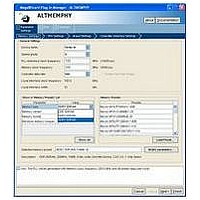IPR-HPMCII Altera, IPR-HPMCII Datasheet - Page 57

IPR-HPMCII
Manufacturer Part Number
IPR-HPMCII
Description
IP CORE Renewal Of IP-HPMCII
Manufacturer
Altera
Datasheet
1.IP-HPMCII.pdf
(176 pages)
Specifications of IPR-HPMCII
Software Application
IP CORE, Memory Controllers, SDRAM
Supported Families
Arria II GX, HardCopy III, Stratix III, Stratix IV
Core Architecture
FPGA
Core Sub-architecture
Arria, HardCopy, Stratix
Rohs Compliant
NA
Lead Free Status / RoHS Status
na
- Current page: 57 of 176
- Download datasheet (4Mb)
Chapter 5: Functional Description—ALTMEMPHY
Block Description
December 2010 Altera Corporation
1
■
Loading a mixed pattern is complex, because write latency is unknown at this time.
Two sets of write and read operations (single pin resynchronization (capture) clock
phase sweeps,
to accurately write the mixed pattern to memory.
Memory bank 0, row 0, and column addresses 0 to 55 store calibration data.
Step 3: Read Resynchronization (Capture) Clock Phase
This step adjusts the phase of the resynchronization clock to determine the optimal
phase that gives the greatest margin. The resynchronization clock captures the
outputs of DQS capture registers (DQS is the capture clock).
To correctly calibrate resynchronization clock phase, based on a data valid window,
requires 720° of phase sweep.
Step 4: Read and Write Datapath Timing
In this step, the sequencer calculates the calibrated write latency (the ctl_wlat signal)
between write commands and write data. The sequencer also calculates the calibrated
read latency (the ctl_rlat signal) between the issue of a read command and valid
read data. Both read and write latencies are output to a controller. In addition to
advertising the read latency, the sequencer calibrates a read data valid signal to the
delay between a controller issuing a read command and read data returning. The
controller can use the read data valid signal in place of the advertised read latency, to
determine when the read data is valid.
Step 5: Address and Command Clock Cycle
This step optionally adds an additional memory clock cycle of delay from the address
and command path. This delay aligns the write data to the memory commands given
in the controller clock domain. If you require this delay, this step reruns the calibration
(“Step 2: Write Training Patterns”
calibrate to the new setting.
Step 6: Postamble
This step sets the correct clock cycle for the postamble path. The aim of the postamble
path is to eliminate false DQ data capture because of postamble glitches on the DQS
signal, through an override on DQS. This step ensures the correct clock cycle timing of
the postamble enable (override) signal.
Step 7: Prepare for User Mode
In this step, the PHY applies user mode register settings and performs periodic VT
tracking.
VT Tracking
VT tracking is a background process that tracks the voltage and temperature
variations to maintain the relationship between the resynchronization or capture
clock and the data valid window that are achieved at calibration.
Mixed: ‘b0011 - DDIO high and low bits have to toggle
(“Step 3: Read Resynchronization (Capture) Clock
to
Section II. DDR3 SDRAM Controller with ALTMEMPHY IP User Guide
“Step 4: Read and Write Datapath
External Memory Interface Handbook Volume 3
Phase”) are required
Timing”) to
5–5
Related parts for IPR-HPMCII
Image
Part Number
Description
Manufacturer
Datasheet
Request
R

Part Number:
Description:
IP NIOS II MEGACORE RENEW
Manufacturer:
Altera
Datasheet:

Part Number:
Description:
IP CORE Renewal Of IP-XAUIPCS
Manufacturer:
Altera
Datasheet:

Part Number:
Description:
IP CORE Renewal Of IP-10GETHERNET
Manufacturer:
Altera
Datasheet:

Part Number:
Description:
IP CORE Renewal Of IP-ASI
Manufacturer:
Altera
Datasheet:

Part Number:
Description:
IP CORE Renewal Of IP-CIC
Manufacturer:
Altera
Datasheet:

Part Number:
Description:
IP CORE Renewal Of IP-CRC
Manufacturer:
Altera
Datasheet:

Part Number:
Description:
IP CORE Renewal Of IP-ED8B10B
Manufacturer:
Altera
Datasheet:

Part Number:
Description:
CPLD, EP610 Family, ECMOS Process, 300 Gates, 16 Macro Cells, 16 Reg., 16 User I/Os, 5V Supply, 35 Speed Grade, 24DIP
Manufacturer:
Altera Corporation
Datasheet:

Part Number:
Description:
CPLD, EP610 Family, ECMOS Process, 300 Gates, 16 Macro Cells, 16 Reg., 16 User I/Os, 5V Supply, 15 Speed Grade, 24DIP
Manufacturer:
Altera Corporation
Datasheet:

Part Number:
Description:
Manufacturer:
Altera Corporation
Datasheet:










